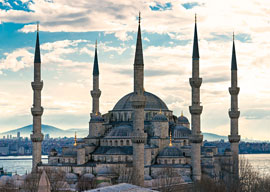
June 19, 2013

Blue Mosque
Source: Shutterstock
Of course, since much of the Empire’s political maneuvering was carried out within lodges, historians are left guessing over what really happened. But it’s clear that the fascinating Ottoman port city of Salonika was the leading entryway for disturbing Western ideas into the stagnant Empire. Salonika is so far west that since 1912 it has been the Greek city of Thessaloniki.
The famous Young Turk revolution that originated in Salonika in 1908 modernized the dynasty. But it also helped plunge the Ottomans into the tumultuous decade and a half from which the formidable Salonikan general Mustafa Kemal Ataturk finally extricated the country by reconfiguring the Ottoman Empire as the nationalist state of Turkey.
The unexpected Young Turk takeover of the Istanbul government was headlined in The New York Times on September 6, 1908: “HOW THE TURKISH REVOLUTION ARRIVED: Salonikan Freemasons and Young Turks Who Won Over the Army.”
The Times explained that for the Young Turk party, “its basis is Freemasonry, which in the last three years has grown prodigiously in Turkey. The Salonika Freemasons, whose very existence was hitherto a profound secret….” (The Times account includes the increasingly baffling subheads: “ACTIVE DR. NAZIM BEY: Another Nazim Bey Turns Informer and Precipitates the Coup by Seeking to Betray Major Enver Bey.” Like I said, this place is complicated.)
Salonika was a multi-ethnic and multi-religious city, with Sephardic Jews making up a plurality and often a majority of the population for most of the centuries after Ferdinand and Isabella expelled the Jews from Spain in 1492. An important modernizing elite within Salonika (until they relocated to Istanbul in the early 20th century) were the crypto-Jewish followers of the 17th-century false messiah Sabbatai Zevi.
Yes, I know it sounds like I”m babbling crazy talk about false messiahs and crypto-Jews, but the role of both “Dönme“ and public Jews in the creation of modern Turkey is increasingly accepted by 21st-century Jewish scholars.
That has not always been so. In 1971, the Jewish historian Elie Kedourie published a scoffing paper entitled “Young Turks, Freemasons and Jews,” in which he pointed and sputtered at the British ambassador to Istanbul’s secret 1910 letter to the Viceroy of India on the “Judeo-masonic and Young Turk conspiracy.”
Admitting the Jewish and crypto-Jewish involvement in the rise of the Young Turks from Salonika is politically difficult for Jewish historians because the Young Turks who went on to rule the Ottoman Empire during World War I ordered the mass expulsions of their Armenian subjects from their traditional homeland near the border of the enemy Russian Empire. In the horrors of 1915, vast numbers of Armenians were killed.
This tragic chain of events, in which initial reformist good intentions went horribly wrong, seems fairly representative of how the world too often works. Yet this would be difficult to reconcile with the conventional wisdom that portrays Jews as wholly powerless victims of history rather than as players in the game like everybody else.
In recent years, however, Jewish historians less worried about stoking anti-Semitic conspiracy theories have been more forthcoming about Jewish and crypto-Jewish historical agency in the Near East. For example, the 2009 Stanford University Press book The Dönme: Jewish Converts, Muslim Revolutionaries, and Secular Turks by UC Irvine historian Marc David Baer states:
The Dönme helped transform Salonika into a cosmopolitan city, promoting the newest innovation in trade and finance, urban reform, and modern education. They eventually became the driving force behind the 1908 revolution that led to the overthrow of the Ottoman sultan and the establishment of a secular republic.
This trend toward greater openness should be applauded. After all, information wants to be free, right?